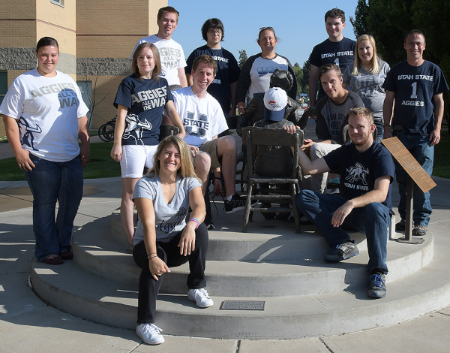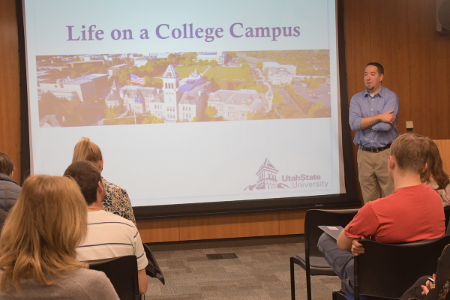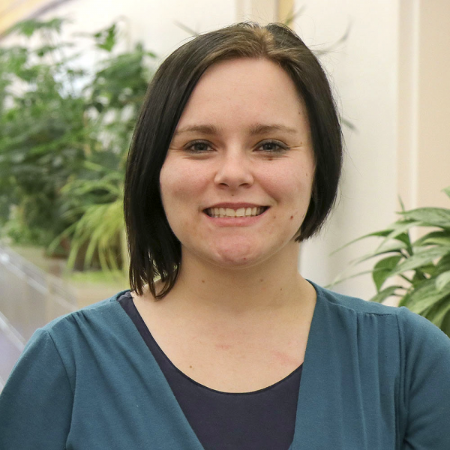Considering College For Students With Intellectual Disabilities

with intellectual disabilities, on the USU campus in 2017.
Students with developmental and intellectual disabilities have been going to college for four years at Utah State University, through the Aggies Elevated Program. The third cohort will graduate in May.
For Dr. Jeff Sheen, the program’s co-principal investigator, higher education for students with intellectual disabilities is not a theoretical concept: it’s a living, growing experience.
He and the Aggies Elevated principal investigator, Dr. Bob Morgan, are taking their presentation, “Why Consider College for Youth with Intellectual and Developmental Disabilities?” to both statewide and nationwide audiences. And while Sheen said the Aggies Elevated program may not be for every student with intellectual disabilities, it does underscore some points about the human experience: Motivation plays an enormous part in success. So does the opportunity to fail, if it is provided in a supportive environment. And nobody should stop learning once high school is over.
Aggies Elevated, located in the Emma Eccles Jones College of Education and Human Services at Utah State University, offers an on-campus, residential program with a two-year Certificate of Integrated College & Community Studies. It is well-integrated within the larger USU campus. Sheen, a researcher at the Center for Persons with Disabilities, said programs like USU’s are not meant for everyone, in much the same way that college is not for every typical student. But it is an important example of life after high school for students with intellectual disabilities.

“Ultimately college is just related to what the human experience is,” Sheen said. “For people without disabilities, high school is not the pinnacle of their learning.” But for students with intellectual disabilities, the expectations for further progress often fade after they leave the public schools. “We haven’t provided them much choice in the matter, frankly. … Why shouldn’t they continue to grow and learn and reach their full capacity?”
That said, the students have to want the experience for themselves. “One of the things we’ve learned as a team is that with the individual motivation, hard work and appropriate supports, some amazing things are possible,” Sheen said. “We’re surprised every day that our students exceed our expectations, just because they’ve been given the opportunity.” One student who struggled early on is now employed full time, with benefits.
But, Sheen said, “When things don’t work out well, it’s because someone else wanted them to be here. … If you don’t have the motivation, it doesn’t matter what supports we provide.”
For motivated students, the supports offered through the AE program make a real difference. Like any student, young adults with a disability will experience some uncertainty as they figure out who they are and adjust to a new, complex environment and way of life. They receive help facing obstacles in time management, organization, and other tasks that typical college students might take for granted, like writing a paper.

“With those things in place, it’s the students that go just as far as they choose to go,” Sheen said.
The supports are also there to help students through the small failures that will most likely come when a large goal is taken on—and to help them recover from them. “Our team’s concept and understanding is of failure is that’s the learning opportunity,” Sheen said. “Failing on a specific task is part of the learning process.” It is through feeling the full weight of consequences that gives students a chance to figure out what to do differently.
A parent contributor to the Aggies Elevated blog put it this way: “As it is with most parents, we tend to do too much for our children, and for children with disabilities, maybe more so. I’m learning to let go and let be…”
The results are impressive, thanks to both the curriculum and internships offered through the program. “As a program, our employment rate at 90 days past graduation is 78 percent,” said AE Career Success Coordinator Sue Reeves in an earlier interview. “The employment rate in general for people with disabilities is only about 19 percent. Our internships, and the skills our students learn from them, are a huge part of that success.”
Heber Morse is currently working in the Logan Assistive Technology Lab an the Center for Persons with Disabilities. His internship has exposed him to power tools, the opportunity to design devices for people with disabilities, and reactions from people he has helped overcome an obstacle. “What really brightens up my day is to fix that problem,” he said in an interview for the UATP blog. “The gratitude they show is wonderful.”
Brenna Manz, an AE graduate, had this to say about her internship at Terrace Grove in Logan: “I learned how to build up my office skills and I also learned how interact with other people by building up my social skills. ... I would help coordinate activities for the residents. I also grew to love the people who worked there and also the residents who live there. They were super kind to me.” Read more about what she had to say on her blog post about getting the job.
Sheen hopes that the work done at USU and other inclusive programs around the state will change attitudes and open doors all over Utah. He looks forward to a future where more adults with disabilities are taking cooking classes in community stores, learning skills at technical colleges and integrating more with life in Utah. He hopes to see institutions that are already providing education to people with disabilities—some disclosed, some not—will continue to expand their offerings and support for students who are not neuro-typical.
“We can encourage people with our experiences, we can share our frustrations and solutions,” Sheen said. “We’re all in this together and we’re still kind of on the front end of the curve on this.”
More information on higher education for students with disabilities can be found on the Think College network.

